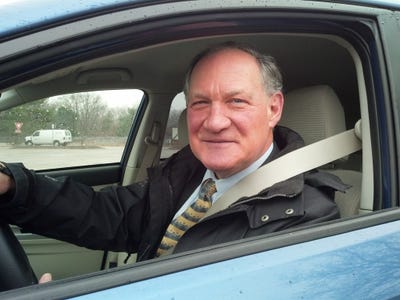Hits & Misses
It was love at first sight, even though Jacquelyn Koslowski only could see the back of the all-new '06 Volkswagen Passat. The rest of it still was shrink-wrapped, freshly delivered to a car dealership near Boston. Koslowski, 52, went to the dealership in July intending to buy a previous-generation Passat. When she expressed an interest in the newly delivered car, it was unwrapped, test driven, purchased

It was love at first sight, even though Jacquelyn Koslowski only could see the back of the all-new '06 Volkswagen Passat. The rest of it still was shrink-wrapped, freshly delivered to a car dealership near Boston.
Koslowski, 52, went to the dealership in July intending to buy a previous-generation Passat. When she expressed an interest in the newly delivered car, it was unwrapped, test driven, purchased and delivered the next day.
It is the sixth generation of VW's midsize cars in North America, beginning with the Dasher in the 1970s. Volkswagen introduced Passat to the market in 1990. That first version was no home run. Sales were only 14,000 units in 1996.
It got better after the previous-generation model debuted in 1998. Sales have averaged about 70,000 units a year since then, peaking at about 90,000 units in 2002.
The new version underwent an extensive self-improvement program. New technical tricks include a braking system that automatically keeps the rotors dry in inclement weather and steering-adaptive bi-xenon headlights that swivel 35 degrees.
There are two formidable new engine choices: a base turbocharged, direct gasoline injection 2L 4-cyl. that replaces the longstanding 1.8L turbo I-4 and a heavily revised and enlarged 3.6L variant of the VR6 “narrow-angle” (10.6°) V-6 that replaces the old 2.8L variant.
No diesel is available, despite VW buyers' strong predilection for compression ignition. There won't be a diesel even next year, says VW, citing stricter new federal emission-control standards in the U.S. The company hopes soon to resolve the emissions issue and add a diesel to the mix.
Pricing ranges from $22,950 to $31,900, with a $650 destination charge. Luxury and sport option packages range from $2,750 to $5,550, which can push the sticker to $37,450 — a credibility-stretching figure for this brand evidenced in many of its newer models that critics believe has contributed to VW's sales nosedive.
The new car is larger than the previous model, yet the drive is as tight, if not tighter. For a relatively big car, it has small-car nimbleness. The body structure is 24 lbs. (11 kg) lighter than the previous model.
It is roomier inside, including 37.7 ins. (96 cm) of rear-seat legroom, a dimension many thought lacking in the previous Passat. That is 2.4 ins. (6 cm) more than before. And, yes, it makes a difference.
Even though the German engineering may seem over-hyped in the marketing mantra, there is a sense of order to driving the Passat, with one movement smoothly progressing to another — be it acceleration, lane changes or quick turns using the well-tuned electro-mechanical power steering.
Koslowski's new Passat has the standard turbocharged 4-cyl., and she confirms our opinion this 100-hp-per-liter powerhouse defies the stereotype of “base” engine.
Models with the new 3.6L DOHC V-6 with 280 hp (90 hp more than the 2.8L it replaces) approach muscle-sedan status. Acceleration is very strong, yet controlled.
VW's early success with the '06 Passat may prove this more powerful new generation is on target with buyers' needs.
The previous car redefined VW's presence in the midsize-sedan segment. From almost every aspect, the new car improves on its ground-breaking predecessor.
The new Passat might just be the shot in the arm VW needs to reconnect with the U.S. market.
'06 Volkswagen Passat 3.6
Vehicle type: Front-engine, front-wheel drive, 5-passenger 4-door sedan
Engine: 3.6L (3,597 cc) DOHC V-6, iron block/aluminum head
Power (SAE net): 280 hp @ 6,200 rpm
Torque: 265 lb.-ft. (380 Nm) @ 2,750 rpm
Compression ratio: 12:1
Bore × stroke (mm): 89 × 96.4
Transmission: 6-speed automatic
Wheelbase: 106.7 ins. (271 cm)
Overall length: 188.2 ins. (478 cm)
Overall width: 71.7 ins. (182 cm)
Overall height: 58 ins. (147 cm)
Curb weight: 3,576 lbs. (1,622 kg)
EPA fuel economy, city/highway (mpg): 19/28
Market competition: Chevrolet Impala; Ford Fusion; Honda Accord; Nissan Altima; Mazda6; Toyota Camry
About the Author
You May Also Like

